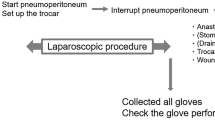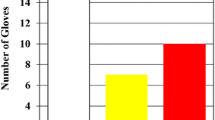Abstract
From February 2001 to May 2001, 792 latex gloves used in 100 operations from three orthopaedic sub-specialties (paediatrics, hand and spine) were tested for puncture by a water infusion test. Sixty-nine gloves from 45 operations were punctured, giving an overall glove perforation rate of 8.7% (69/792) and an operative perforation rate of 45% (45/100). The hand operations had the lowest operative perforation rate (19.4%) while the spine operations had the highest (63.6%). The glove perforation rate increased in bony procedures (60% versus 22.5%), in procedures with major instrumentation (66% versus 18%) and in more lengthy procedures. The thumbs and the left index finger had more punctures than other parts. In addition, the glove perforation rate for single gloving was 9.6% (53/552) while that for the inner glove of double gloving was 0.8% (1/120). Based on these findings, we would like to recommend double gloving and regular glove changing in these high-risk surgeries.
Résumé
De février 2001 à mai 2001, 792 gants en latex, utilisés dans 100 opérations de trois “ sous spécialités ” orthopédiques (Pédiatrie, Main et Colonne vertébrale), ont été testé par une épreuve d’infusion de l’eau. Soixante-neuf gants de 45 opérations étaient perforés, en donnant un taux de la perforation global du gant de 8.7% (69/792), et un taux de perforation pendant l’ opération de 45% (45/100). Les opérations de Main avaient le plus bas taux de perforation en opération (19.4%), pendant que les opérations de la Colonne vertébrale avaient le plus haut (63.6%). Le taux de la perforation des gants augment dans les procédures osseuses (60% contre 22.5%), dans les procédures avec instrumentation majeure (66% contre 18%), et dans les plus longues procédures. Les pouces et l’index gauche avaient plus de perforations que d’autres parties de la main. De plus, le taux de la perforation du gant en cas de gant unique était de 9.6% (53/552) tandis que pour le gant intérieur en cas de double gantage ce taux était de 0.8% (1/120). Basé sur ces conclusions, nous recommandons des doubles gants et un changement régulier du gant dans ces chirurgies à haut risque.
Similar content being viewed by others
References
Chiu KY, Fung B, Lau SK, Ng KH, Chow SP (1993) The use of double latex gloves during hip fracture operations. J Orthop Trauma 1:354–356
Dalgleish AG, Malkovsky M (1988) Surgical gloves as a mechanical barrier against immunodefiency viruses. Br J Surg 75:171–172
Dodds RDA, Guy PJ, Peacock AM, Duffy SR, Barker SGE, Thomas MH (1988) Surgical glove perforation. Br J Surg 75:966–968
Gunasekera PC, Fernando RJ, De Silva KKRR (1997) Glove failure; an occupational hazard of surgeons in a developing country. J R Coll Surg Edinb 42:95–97
Herscovici D Jr, DiPasquale, Sanders R (1998) Comparison of cloth gloves used in orthopaedic surgery: a clinical and experimental evaluation. J Orthop Trauma 12:106–110
Kelen GD, Fritz S, Qaqish B, Brookmeyer R, Baker JL, Kline RL, Cuddy RM, Goessel TK, Floccare D, Williams KA, Silvertson KT, Altman S, and Quinn TC (1988) Unrecognized human immunodeficiency virus infection in emergency department patients. New England J Med 318:1645–1650
Louis, Steven S, Steinberg EL, Gruen OA, Bartlett CS, Helfet DL (1998) Outer gloves in orthopaedic procedures: a polyester/stainless steel wire weave glove liner compared with lalex. J Orthop Trauma 12:101–105
Maffulli N, Capasso G, Tetsa V (1989) Glove perforation in elective orthopaedic surgery. Acta Orthop Scand 60: 565–566
Maffuli N, Testa V, Capaso G (1991) Glove perforation in foot surgery. foot ankle 11:228–230
McLeod GG (1989) Needlestick injuries at operation for trauma: are surgical gloves an effective barrier? J Bone Joint Surg [Br] 71:489–491
Sanders R, Fortin P, Ross E, Helfet D (1990) Outer gloves in orthopaedic procedures: cloth compared with latex. J Bone Joint Surg [Am] 72:914–917
Thanni LOA, Yinusa W (1998) intraoperative glove failure: a surgical hazard. Nigerian Journal of Clinical Practice 1:103–105
Acknowledgement
We wish to thank the nursing officer in charge, Isodora Wong, and the entire members of staff of the operating theatre of DKCH for their assistance during the course of this study, and Duosai Lu for his assistance in statistical analysis of the data.
Author information
Authors and Affiliations
Corresponding author
Rights and permissions
About this article
Cite this article
Yinusa, W., Li, Y.H., Chow, W. et al. Glove punctures in orthopaedic surgery. International Orthopaedics (SICOT) 28, 36–39 (2004). https://doi.org/10.1007/s00264-003-0510-5
Accepted:
Published:
Issue Date:
DOI: https://doi.org/10.1007/s00264-003-0510-5




